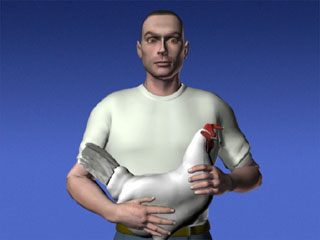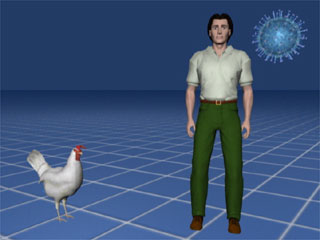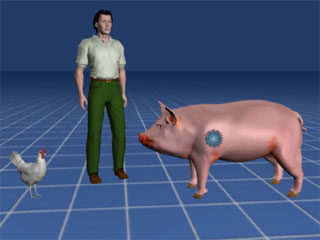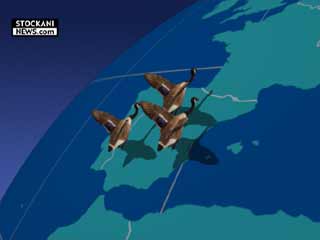AVIAN FLU |
H5N1 VIRUS

VIRUS MUTATION


THE MUTATION THREAT


SPRING MIGRATIONS

animation(s) available on request on our ftp as 768x576 pixels numbered jpg files ready to be imported in an editing software such as Avid, Final Cut, After Effects, Combustion or others, or as mpg4 movie(s)
|
pricing : 3D News Graphics animations |
From
Wikipedia, the
free encyclopedia
Influenza A (H5N1) virus – also called “H5N1 virus” – is an influenza A virus subtype that occurs mainly in birds, is highly contagious among birds, and can be deadly to them. H5N1 virus does not usually infect people, but infections with these viruses have occurred in humans. Most of these cases have resulted from people having direct or close contact with H5N1-infected poultry or H5N1-contaminated surfaces. Infected birds shed influenza virus in their saliva, nasal secretions, and feces. Most cases of avian influenza infection in humans have resulted from contact with infected poultry H5N1 is an Influenza A virus subtype. The H5N1 flu is what is commonly meant when speaking of "bird flu" or "avian influenza". It is a viral disease that causes illness in many species including humans and is a pandemic threat. Experts believe it might mutate into a form that transmits easily from person to person. If such a mutation occurs, it might remain an H5N1 subtype or could shift subtypes as did H2N2 when it evolved into the Hong Kong Flu strain of H3N2. Within the bird population, the spread of H5N1 is potentially global in scope, though is extremely rare in humans. It is very easy for many species of birds to catch H5N1 from each other. Most humans known to have become infected had a lot of physical contact with infected birds, or, rarely, an infected relative. While H5N1 is mutating into variations which infect species not previously known to carry the virus, not all of these variations can infect humans. Scientists suspect that H5N1 is hard to spread from human to human because the virus infects cells deep in the lungs (and other organs as the disease progresses), not nasal passage cells. Because of this, the virus doesn't shed from the nose (or other upper respiratory cells), so sneezing and coughing don't spread the disease. A highly pathogenic variation of H5N1 is currently spreading across the world from areas where it is endemic. Migrating waterfowl (wild ducks, geese, and swans) carry H5N1, often without themselves becoming sick. H5N1 is also spread through domestic poultry, both through movements of infected birds and poultry products, and the use of infected poultry manure as fertilizer or feed. Humans with H5N1 have typically caught it from chickens, which were in turn infected by other poultry or waterfowl. H5N1 is currently endemic in birds in southeast Asia and is threatening to become endemic in birds worldwide. Tens of millions of birds have died of H5N1 influenza and hundreds of millions of birds have been slaughtered and disposed of to try to control the spread of the disease. The current projected worst case scenario for a H5N1 pandemic is somewhere around 150 million human deaths directly due to H5N1 infection (or two to three percent of the world's human population). The likelihood of this scenario is unknown. Links : http://www.cdc.gov/flu/avian http://en.wikipedia.org/wiki/H5n1 |
© michel leconte 2009